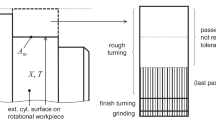Abstract
This paper proposes a three-dimensional approach towards manufacturing tolerancing that uses a strategy to strictly consider the definition of a datum system imposed by ISO standards. This approach, called three-dimensional manufacturing tolerancing (TMT), is based on the small displacement torsor, which describes the possible deviations between machined surfaces and nominal surfaces of the part model. Every requirement of the definition drawing is treated separately with its own calculation model. The iterative ascending analysis allows one to establish the influence of the most recent phase and determine the influential parameters from previous phases. The nominal part model is defined on the datum systems of the requirement, and deviations are expressed with respect to both the machining process and the chosen machine adjustment method. The result takes the form of a formula that yields the variation in characteristics specified in the requirement based on quantifiable parameters identified on the machine.
Similar content being viewed by others
References
Hong YS, Chang TC (2002) A comprehensive approach of tolerancing research. Int J Prod Res 40(11):2425–2459
Bourdet P (1973) Chaînes de cotes de fabrication : première partie Modèles, L’ingénieur et le Technicien de l’Enseignement Technique, Décembre
Anselmetti B, Bourdet P (1993) Optimisation of a workpiece considering production requirements. Computers in Industry - N° 21 - pp. 23–34 ELSEVIER - January 1993
Anselmetti B (2003) Cotation de fabrication et métrologie, Edition Hermes Lavoisier
Bourdet P, Ballot E (1995) Geometrical behaviour laws for computer aided tolerancing. In Computer Aided Tolerancing, Proceedings of 4th C.I.R.P. Seminars on Computer Aided Tolerancing, Tokyo, 5–6 April 1995, pp 143–154
Ballot E, Bourdet P (1996/5) Présentation à partir d’un exemple du calcul des chaînes de cotes 3D, Revue Technologies et Formations, n°68, Paris, pp 23–27
Thiebaut F (2001) Contribution à la définition d’un moyen unifié de gestion de la géométrie réaliste basé sur le calculs des lois de comportement des mécanismes, Thèse de doctorat, ENS de Cachan LURPA
Villeneuve F, Vignat F (2003) 3D synthesis of manufacturing tolerances using a SDT approach, The 8th CIRP International Seminar on Computer Aided Tolerancing, 28–29 April 2003, Charlotte, North Carolina, USA
Villeneuve F, Legoff O, Landon Y (2001) Tolerancing for manufacturing a three-dimensional model. Int J Prod Res 39(8):1625–1648
Tichadou S, Legoff O, Hascoët J (2004) Process planning geometrical simulation: compared approaches between integrated CAD/CAM system and Small displacement torsor model, Bath, UK, April 5–7, 2004 IDMME
Louati J, Ayadi B, Bouaziz Z, Haddar M (2006) Three-dimensional modelling of geometric defaults to optimise a manufactured part setting. Int J Adv Manuf Technol 29(3–4):342–348
Teissandier D, Couétard Y, Gérard A (1997) Three-dimensional Functional Tolerancing with Proportional Assembly Clearance Volume (U.P.E.L.), application to setup planning, 5th CIRP CAT Seminar, Toronto, Canada, pp 113–124
Kanaï S, Onozuka M, Takahashi H (1995) Optimal tolerance synthesis by genetic algorithm under the machining and assembling constraints, 4th CIRP CAT Seminar, Tokyo, Japan, pp 263–282
Clément A, Le Pivert P, Rivière A (1996) Modélisation des procédés d’usinage Simulation 3D réaliste, IDMME’96, Nantes, France, pp 355–364
Thimm G, Lin J (2005) Redimensioning parts for manufacturability: a design rewriting system. Int J Adv Manuf Technol 26:399–404
Desrochers A (2003) A CAD/CAM representation model applied to tolerance transfer methods. J Mech Des 125(1):14–22, March
Anselmetti B, Louati H (2005) Generation of manufacturing tolerancing with ISO standards. Int J Mach Tools Manuf, 1124–1131, August
Anselmetti B (2006) ISO manufacturing tolerancing with tolerance zone transfers. Revue Int D'ingénierie Mécanique 2(1–2):57–70
Anselmetti B (2006) Generation of functional tolerancing based on positioning features. Comput-Aided Des 38:902–919
Vignat F (2005) Contribution à l’élaboration d’un modèle 3D de simulation de fabrication pour l’analyse et la synthèse des tolérances, le modèle MMP, Mémoire de thèse de l’institut national polytechnique de Grenoble
Ayadi B, Anselmetti B, Bouaziz Z, Zghal A (2007) Modélisation tridimensionnelle des transferts de cotes de fabrication, 2ème Congrès International CMSM, Monastir, Tunisia, 19–21 March 2007, n°181
Author information
Authors and Affiliations
Corresponding author
Rights and permissions
About this article
Cite this article
Ayadi, B., Anselmetti, B., Bouaziz, Z. et al. Three-dimensional modelling of manufacturing tolerancing using the ascendant approach. Int J Adv Manuf Technol 39, 279–290 (2008). https://doi.org/10.1007/s00170-007-1225-3
Received:
Accepted:
Published:
Issue Date:
DOI: https://doi.org/10.1007/s00170-007-1225-3



